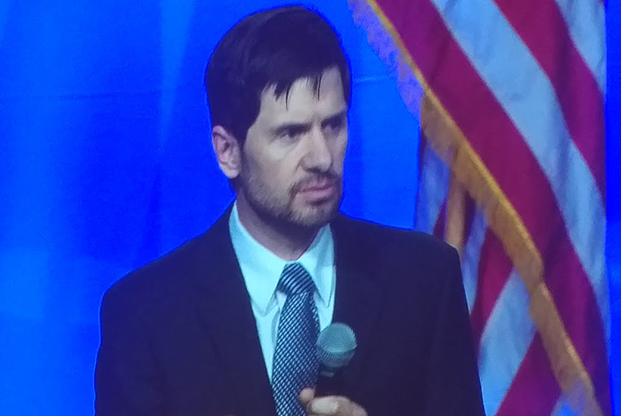
Anthony Grieco, who leads leads Cisco's Trust Strategy Office, appeared on a Sept. 18 panel at AFA's 2018 Air, Space and Cyber Conference in National Harbor, Md. Photo by Shaun Waterman.
The Air Force needs to embrace the coming generation of Internet-connected devices and sensors and become less risk-averse, if it is to capitalize on the amazing new capabilities of the latest technology, AFA’s 2018 Air, Space & Cyber Conference? was told on Tuesday.
“Risk aversion is one of the big things that’s holding us back from empowering our airmen to do the things that they know how to do,” especially in the technological sphere, Air Force Vice Chief of Staff Gen. Stephen Wilson told a session on the “Internet of Things.”
The advent of the IoT — networks of connected, computerized devices collecting data which feed increasingly automated decision-making — has opened new possibilities for enterprises of all kinds. But it also opens a new attack surface for hackers, cyber spies, and online criminals.
The military services and the government as a whole have traditionally been cautious about those risks — and they’re not alone.
A recent survey by Cisco of its 1,000 largest customers found that 70 percent of the executives of these big enterprises “have come to the view that cybersecurity is the reason why they’re not innovating and transforming their business,” said Anthony Grieco, who leads leads the company’s Trust Strategy Office.
Forty percent said they had stopped a major transformational activity to digitize their business because of cybersecurity concerns, he added. “Think about that. They were ready to do something to disrupt their own business within its walls and they were stopped by cybersecurity,” Grieco said.
That matters because enterprises that lose their place on the leading edge of technology won’t survive, he added. “Any business you do business with today, any government, any one that is not disrupting themselves today and challenging themselves to innovate is one that is not going to be around for another 10 years,” he predicted.
Thaddeus Arroyo, CEO of AT&T Business, agreed. If he was able to wave a magic wand, he said, he would use it to increase the “speed to deployment” of new technologies. US enterprises, including the government and military needed to be more “quick and agile in how we’re assessing risks and operationalizing the latest technologies,” he said.
General Wilson agreed. “We’ve been lulled into this world where we’ve become … too risk- averse, too regulated, too stovepiped, too analog for the digital world,” he said.
“We have to develop a sense of urgency. The status quo just won’t work,” he concluded.
Grieco acknowledged that there were difficult conversations to have about the potential downside of embracing the IoT world. “The question on everyone’s mind is ‘Are we taking on too much risk?’” he said.
IoT devices, many of which are low-cost consumer items like webcams, have acquired a reputation as insecure out of the box and moreover often cannot be patched or updated, meaning that they become more vulnerable to hackers over time. But Grieco said that reputation was undeserved.
“It’s true there are lot of things that are connected to the network today that aren’t secure … that doesn’t mean that all of them are insecure or that all of them cannot be secured,” he argued.
In any case, he added, there was no stopping the IoT juggernaut.
“It is inconceivable that we will slow down the adoption of devices connected wired or wirelessly to networks that are driving sensor for analytics that are driving automated decision-making,” he said.
“I don’t care what [business] you’re in: Finance or healthcare, the military or civil service; ultimately that is the trend that will drive efficiency and capability, and that’s where we’re going.”
“The conversation about risk is a healthy conversation,” he admitted. “But what we can’t have happen is we become afraid to go down that path and become stymied by the idea that it isn’t secure. That is a path to sure failure.”
Given that, General Wilson added that a new paradigm was needed. “Our job is to remove the barriers … empower that [spirit of transformation] and take it out of this very risk-averse, micromanagement world that we’ve been living in for the past 20-some years. That’s the big change that’s coming,” he said.
“We’re not slowing down, so we have to think our way through that problem [of security],” he added.
At last year’s wing commanders’ conference, he said, the Air Force Chief of Staff had urged the service’s officer corps to embrace risk. “His message was, ‘I trust you, go long, don’t wait for me,’” Wilson said.
The embrace of risk and change needed to be reflected in the service’s culture and in its personnel if the US military was to prevail against near-peer adversaries like China, which he pointed out will graduate eight times as many STEM students as the US this year.
“The type of people we need are people who are not content with the status quo. The only constant in the world is change, and so we’ve got to have people with the culture and the mindset that is able to adopt and adapt because in the future fight, speed wins.”